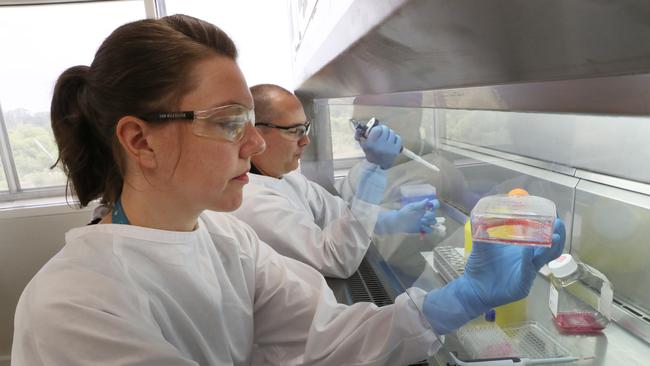CSIRO scientists helps unearth ‘warm’ Covid-19 vaccine
CSIRO scientists are helping solve one of the biggest problems of the Covid-19 vaccine rollout.

As Geelong finds itself a hotspot in Australia’s latest coronavirus outbreak, researchers in Victoria’s second biggest city are on the verge of a Covid-19 breakthrough and solving one of the biggest problems with the vaccine rollout.
In a beige building on the shores of Corio Bay, within eyesight of Alcoa’s abandoned aluminium smelter, is the Australian government’s main lab for fighting coronavirus, the Australian Centre for Disease Preparedness.
And it is here CSIRO researchers have been working on Covid-19 therapies and vaccines since the pandemic began, including evaluating the AstraZeneca jab. Now it looks like they have solved one of the main challenges in distributing the current range of coronavirus vaccines: temperature control.
Unlike all the current vaccines which must be stored at either 2-8 degrees centigrade, like the AstraZeneca jab, or the colder-than-the-south pole Pfizer vaccine, which must be kept at minus 70 degrees, CSIRO scientists have helped discover a “warm vaccine”.
The agency’s researchers collaborated with the Indian Institute of Science and biotech start-up Mynvax to evaluate the effectiveness of a Covid-19 vaccine that remains stable at 37 degrees — or body temperature.
The study found that the vaccine still provided a “strong immune response” in mice and protected hamsters from Covid-19, with it remaining effective stored at body temperature for a month and even at 100 degrees — or water boiling temperature — for 90 minutes.
Professor S.S. Vasan, CSIRO’s Covid-19 project leader and study co-author, said the Mynvax-vaccinated mice serums show a strong response to all variants of the live virus - including the Delta variant that has forced Sydney into an extended lockdown and Melbourne into its fifth shutdown.
“Our data shows that all formulations of Mynvax tested result in antibodies capable of consistent and effective neutralisation of the Alpha, Beta, Gamma and Delta SARS-CoV-2 variants of concern,” Dr Vasan said.
The researchers plan to complete human clinical trials in India later this year. If the study can be replicated in humans, CSIRO health and biosecurity director Rob Grenfell said it would not just be developing countries that would benefit from the vaccine.
“A thermostable or ‘warm vaccine’ is critical for remote or resource-limited locations with extremely hot climates which lack reliable cold storage supply chains, including regional communities in Australia’s outback and the Indo-Pacific region,” Dr Grenfell said.
“Since the start of the pandemic, CSIRO has played a crucial role in fighting Covid-19 by conducting preclinical evaluation of two Covid-19 vaccines including Oxford-AstraZeneca, tracking emerging variants of concern, and monitoring wastewater to detect hot spots in the community.”

Governments across the globe have faced a mammoth challenge distributing the current range of approved Covid-19 vaccines, with the Australian government tapping into the cold chain distribution networks of German logistic titan DHL and Linfox, which delivers chilled and frozen groceries to Australia’s main supermarket chains.
“The challenge starts at the very, very last mile when we deliver this vaccine to places where there is not a freight (infrastructure) that can display a temperature like that. These are challenges that we need to work together with governments to solve going forward,” DHL chief commercial officer Katja Busch said.
The DHL released a study it completed with McKinsey last September that showed even when leveraging existing freight infrastructure, the share of the world’s population with good access to a vaccine only increases to about 70 per cent, reaching a total population of about five billion in about 60 countries.
“Feasibility for supplying substantial parts of Africa remains low due to high outside temperatures and limited cold chain infrastructure. It is therefore important to consider innovative and specialised transportation modes to reach populations in less accessible regions,” the study said.




To join the conversation, please log in. Don't have an account? Register
Join the conversation, you are commenting as Logout